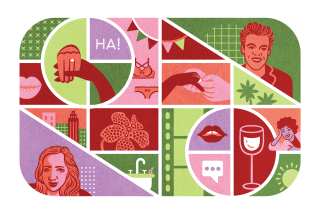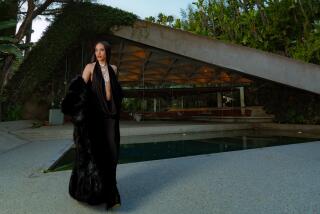The New Colors of Love
- Share via
Kim Stevenson thinks of herself as an old-fashioned girl. So when she and her fiance got engaged, they went shopping for a diamond ring, just like they were supposed to. “I looked at diamonds and I just didn’t feel much,” said Stevenson, 36. “They just seemed so plain to me.”
She came home instead with a velvety blue sapphire that spoke to her soul. The crystal blue of the stone makes her think of the ocean, the sky and the time she and her man lived by the beach, during their early courtship. “I didn’t expect to get a sapphire,” said Stevenson, a writer who lives in Thousand Oaks and plans to marry in June. “But I guess I wasn’t going to let tradition make me wear a ring I didn’t like.”
I know what she means. I recently became engaged and had to face the diamond dilemma, too. Diamonds are a symbol of love, but I don’t really like them. I prefer the fire of rubies, and the glow of emeralds to the cool sparkle of diamonds. So for my engagement ring, my fiance and I chose a ring with an Australian opal that glimmers green and blue like winter waves. It was designed by goldsmith Amy Moss, who works out of a horse trailer in Malibu, and I love it.
But I have to wonder, will people even know it’s an engagement ring? In some repressed feminist way, do I secretly like that they might not? Am I a contrarian freak?
Much as I hate to admit it, I seem to be part of a trend, albeit a small one.
Moss, who designs custom jewelry that looks like it was unearthed from Egyptian tombs, said her clients are often interested in unusual pieces.
“Diamonds will always be beautiful,” Moss said. “But they are more of a man’s idea of doing what their Mom wanted. It’s not the creative decision. It’s the young, blushing bride that will choose a diamond. It usually indicates the wealth of the husband.”
Clearly the vast majority of women--and, more important, men--still believe diamonds are a girl’s best friend. But evidence is emerging--in anecdotes and in the press--that there is growing interest in non-diamond engagement rings.
“It’s just a nontraditional choice that more and more people are prepared to make,” said Douglas Hucker, executive director of the Dallas-based American Gem Trade Assn., which promotes the sale of colored gemstones in North America. “I think people are feeling less constrained by tradition all the time.”
Michelle Orman, spokeswoman for New York-based Jewelry Information Center, said that alternative gemstones made a splash in 1981, when Lady Diana Spencer--who starred in the biggest bridal princess fantasy in the latter half of the last century--was presented with a sapphire engagement ring, surrounded by diamonds. The choice startled a world trained to love diamonds, and opened the door, ever so slightly, to options.
The more recent interest in alternative gemstone rings, said Orman, is driven by demographics and economics. Women are marrying later, making more money and developing their own sense of identity and style before they wed. Between 1998 and 1999--the most recent period for which statistics are available-- women spent $12.1 billion on diamond jewelry for themselves, a 41% increase over the year before, according to Orman.
By the time these “female self-purchasers” get engaged, they have already draped sapphires around their necks, hung rubies from their ears, or slipped diamonds onto their own fingers.
“The few extra years of singledom serves to solidify one’s personal tastes,” said Elizabeth Florence, the Jewelry Information Center’s executive director. “More than ever, women are involved in the process of picking out the engagement ring. If they prefer a different gem, they are not afraid to address that.”
Jane Bohan, an award-winning New York-based designer who focuses on gemstone jewelry, says part of this shift is simply availability. “You think of what was offered 20 years ago, and you just did not see a sapphire with these arrangements around them,” she said.
The glossy pages of women’s bridal magazines reflect this increased openness, availability--and curiosity--about non-diamond rings. “Perhaps by now you’ve noticed the color-is-hot trend in all things bridal,” begins an article titled “Gem Dandy” in the November/December 2001 issue of Bridal Guide.
“Is a diamond really my best friend--or would I swap her for a sapphire?” asks “Ring in the New,” an article in In Style’s January wedding issue. Modern Bride plans to run a story on sapphire engagement rings in its June/July issue.
“Slowly, things are starting to change,” said Tania Riddell, Modern Bride’s accessories editor. “Slowly, you are seeing more colored rings out there. Women, girls, just want something different. There are just so many choices out there, and finally consumers are becoming aware of that.”
To be sure, most women will stick with diamonds. According to the Diamond Information Center, which tracks industry trends, 84% of all U.S. brides celebrated their engagement with a diamond engagement ring last year.
And Rob Bates, diamond reporter for the trade publication Jeweler’s Circular Keystone, said he does not see any evidence of a trend of women opting for stones other than diamonds. “De Beer’s research from the last year shows that acquisition rates are steady,” Bates said. “I think they [gemstones] are something that a more sophisticated customer might want. But you have got to understand that most people buying engagement rings are men. They can barely understand buying a diamond, and then all of a sudden he is supposed to buy a sapphire, or a ruby? He is just totally clueless.”
It’s hard to get reliable information on the history of engagement rings from a source not affiliated with the diamond industry. But before the middle of the last century, if women even wore an engagement ring, it would typically contain her birthstone.
The grip of the diamond on the American psyche did not come until the 1930s, when De Beers--which by then controlled an estimated 90% of the world’s rough diamonds-- hired the advertising agency NW Ayer to win over the largest market in the world.
In 1947, a copywriter at NW Ayer coined the slogan “A diamond is forever.” That phrase is the most recognized ad slogan of the 20th century, according to Advertising Age.
De Beers also came up with the “rule” that a man should spend one month’s salary on a diamond engagement ring; somewhere along the way that leaped to two months’ salary.
Bates said De Beers has successfully made diamond engagement rings into a “cultural imperative.”
“The whole idea behind diamond advertising is that a man doesn’t love you if he doesn’t give you a diamond ring. The diamond you give symbolizes how much you love her. It is very clever ... ‘If you love your fiancee, you will write a check to us.’”
So far, no one has been able to sever the tie between diamonds and love. “I think that when you have an organization like De Beers, which spends $200 million a year advertising love and romance, it is hard to get a woman to think of anything else,” said William E. Boyajian, president of the Carlsbad-based Gemological Institute of America, which trains jewelers. “It keeps people from thinking of other stones, unless they have a genuine love for rubies, sapphires or opals. I think it just does not even occur to you. There is no De Beers of the colored-stone world.”
Hucker of the American Gem Trade Assn. does not dispute that diamonds remain the engagement ring of choice, but said the way data are collected is unlikely to pick up on new trends. “I don’t think there are any statistics on how many women buy colored gemstones as opposed to diamonds for their engagement rings,” he said. “It has not been a tradition to ask, ‘How many of your rings used natural colored stones as the center stone?’”
In recent years, reports that trade in rough diamonds has funded and prolonged bloody regional conflicts in Africa threatened to taint the carefully cultivated image of diamonds. But the industry has taken steps to avoid a public relations debacle. (See accompanying story.)
Unlike gold, which has a world market price, the price of jewels ranges widely. According to Stuart Robertson, research director of Gemworld International, which publishes the Guide, the retail price for a top-quality, 1-carat, brilliant-cut stone varies widely--from $2,700 to $3,600 for a sapphire; $4,500 to 5,500 for an emerald; $5,000 to 7,500 for a ruby; and $13,000 to $16,500 for a diamond.
The De Beers logic worked with Shawn O’Connor, 42, of Redondo Beach, who proposed to his girlfriend April 5 with a diamond ring. “Anything less than a diamond is ... not looked down on, but certainly something you have to consider. How true could my feelings be if I skimp on a diamond for her?”
Women who opt for non-diamond rings seem to play an active role in selecting their rings, and seem to be slightly older than the average first-time bride, who is 25. Diane Martinson of New York got married for the first time in her late 40s to a man she met on a garden tour of Italy. She wears a second-century Roman ring of imperial gold with a jasper and a figure of a lion. It is so tiny she must wear it on her pinkie.
“My husband offered me his grandmother’s diamond in a Tiffany setting, a lovely setting with prongs and everything,” she said. “I didn’t want to hurt his feelings, but I said, ‘I would never really wear that ring.’
“I told my mother I had turned the diamond down and she said, ‘What, are you, nuts?’”
Often women who receive alternative gemstone rings have an unusual ring somewhere in their family history. That was true for Emily Culbertson, 30, of Philadelphia as well as her fiance. Her own mother had two engagement rings--a diamond and an opal; her fiance’s mother had a ruby.
But finding something different proved more difficult than she thought. “It’s not as easy or simple to walk into a jeweler and say, ‘I’d like to see six sapphires,’ as it is to walk in and say, ‘I’d like to see six square-cut diamonds,’” said Culbertson, who researched rings for weeks on the Internet.
In the end, she bought a sapphire she loves from a jeweler in Boise, Idaho. “I can still do what every engaged women does,” Culbertson said. “Which is hold up my hand, and there is a ring on my fourth finger and people know I am engaged. In that way, it has been effective.”
Do men feel slighted when their women choose color?
Mark Henderson, 41, of Thousand Oaks, who will tie the knot with Kim Stevenson in June, said the idea of breaking with the diamond convention appealed to him. Above all, though, he wanted to choose a ring that made his fiancee happy. “To me a ring is a ring,” he said. “Whether it is plastic or a solitaire diamond, to me it doesn’t make a great deal of difference.”


